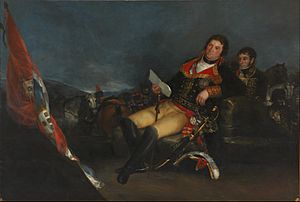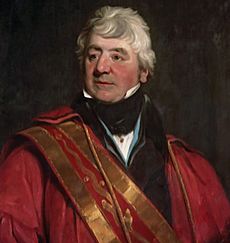Rokeby Venus facts for kids
The Rokeby Venus ( ROHK-bee; also known as The Toilet of Venus, Venus at her Mirror, Venus and Cupid; Spanish: La Venus del espejo) is a painting by Diego Velázquez, the leading artist of the Spanish Golden Age. Completed between 1647 and 1651, and probably painted during the artist's visit to Italy, the work depicts the goddess Venus, lying on a bed and looking into a mirror held by her son Cupid. The painting is in the National Gallery, London.
In this work, Velázquez combined two established poses for Venus: recumbent on a couch or a bed, and gazing at a mirror. She is often described as looking at herself in the mirror, although this is physically impossible since viewers can see her face reflected in their direction. This phenomenon is known as the Venus effect. In a number of ways the painting represents a pictorial departure, through its central use of a mirror, and because it shows the body of Venus turned away from the observer of the painting.
The painting was hung in the houses of Spanish courtiers until 1813, when it was brought to England to hang in Rokeby Park, Yorkshire. In 1906, the painting was purchased by National Art Collections Fund for the National Gallery, London. Although it was attacked and badly damaged in 1914 by the suffragette Mary Richardson, it soon was fully restored and returned to display.
Provenance
The Rokeby Venus was long held to be one of Velázquez's final works. In 1951, it was found recorded in an inventory of 1 June 1651 from the collection of Gaspar Méndez de Haro, 7th Marquis of Carpio, a close associate of Philip IV of Spain. Haro was the great-nephew of Velázquez's first patron, the Count-Duke of Olivares.

The painting is difficult to date. Velázquez's painting technique offers no assistance, although its strong emphasis on colour and tone suggest that the work dates from his mature period. The best estimates of its origin put its completion in the late 1640s or early 1650s, either in Spain or during Velázquez's last visit to Italy. If this is the case, then the breadth of handling and the dissolution of form can be seen to mark the beginning of the artist's final period. The conscientious modelling and strong tonal contrasts of his earlier work are here replaced by a restraint and subtlety which would culminate in his late masterpiece, Las Meninas.
The painting passed from Haro into the collection of his daughter Catalina de Haro y Guzmán, the eighth Marchioness of Carpio, and her husband, Francisco Álvarez de Toledo, the tenth Duke of Alba. In 1802, Charles IV of Spain ordered the family to sell the painting (with other works) to Manuel de Godoy, his favourite and chief minister. The painting disappeared from the Godoy palace during the Napoleonic invasion of Spain, and passed through the hands of George Augustus Wallis, a British painter, who worked in Spain as an agent for William Buchanan, a major art dealer, who brought it to England in 1813.
In October 1813 Buchanan had offered shares in a package of twenty-four top paintings from Spanish collections to wealthy English collectors, who would be able to either buy them themselves, or share in the profits from sales to others in London. The Venus was one of them. This arrangement was similar to that by which the cream of the Orleans Collection had been brought to London some years earlier.
In England it was purchased by John Morritt for £500 (£ 24,000 in 2024), and on the advice of his friend Sir Thomas Lawrence. Morritt hung it in his house at Rokeby Park, Yorkshire—thus the painting's popular name. In 1906, the painting was acquired for the National Gallery by the newly created National Art Collections Fund, its first campaigning triumph. King Edward VII greatly admired the painting, and anonymously provided £8,000 (£ 620,000 in 2024) towards its purchase, and became Patron of the Fund thereafter.
See also
 In Spanish: Venus del espejo para niños
In Spanish: Venus del espejo para niños
- List of works by Diego Velázquez


